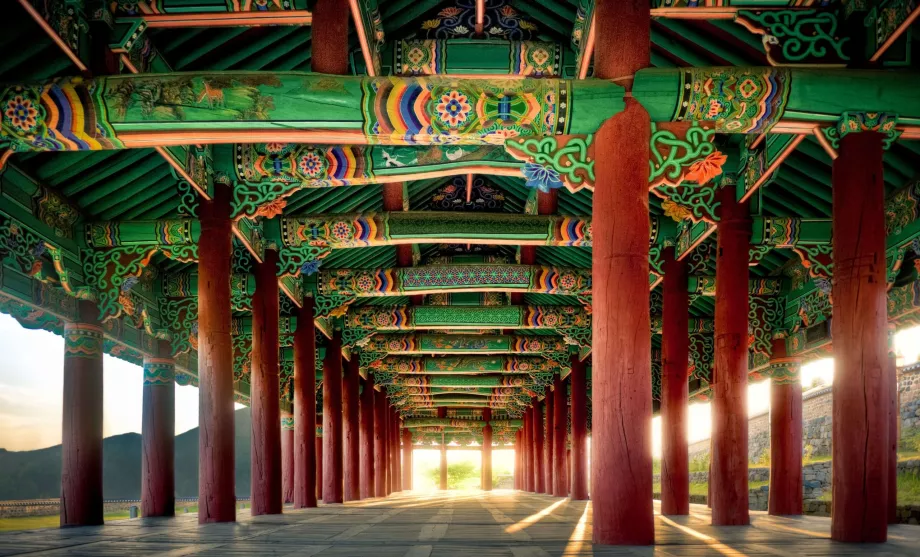Weather in South Korea and best time to go

The climate of South Korea is very specific and can hardly be compared to other areas of the world. Officially, Korea lies in a temperate zone with four seasons.
However, summers are often more like the tropics and winters can be much colder than, for example, in European temperate countries, despite the fact that Korea lies further south.
Even though Korea is a peninsula, the climate is more continental, as most of the influence comes from the west, the vast Asian landmass. The wet monsoon season, in which oceanic influence prevails, occurs in summer and early autumn.
Find flights to Seoul in high season
The differences in temperature and weather between summer and winter are great. The average temperature in Seoul in January ranges from -12°C to +1°C, while in July it ranges from 24°C to 30°C. Winter and spring are also significantly drier than summer.
The climate within the different Korean regions does not vary much. In general, the east coast and the north around Seoul are more rainy. The southern coast is warmer, but the difference from the north is at most 5-6 degrees. A few extra degrees prevail on the popular holiday island of Jeju, which is also the southernmost outpost of the Republic of Korea.
When does it rain the most in Korea?
The wet and very sultry rainy season coincides with a summer that is more like the tropics than a temperate climate zone. The rainiest months are July and August, when heavy thunderstorms occur. On average, every second day, but it is not uncommon to have more than one storm per day.
Are there typhoons in Korea?
Korea lies on the edge of the typhoon belt in East Asia. The risk is not as strong as in Japan, the Philippines or eastern China, but it still exists.
On average, a typhoon visits South Korea 1-2 times a year. It brings torrential rains that can last for 3 days straight and strong winds. It usually appears on the southern coast or Jeju Island in August or the first half of September.
When do the cherry blossoms bloom?
The popular cherry blossom season, which Korea is literally dotted with, dates back to late March/early April.
Table of temperatures during the year
Soul - Northern half of the country + west coast
Busan - Southern half of Korea
Jeju - Temperatures on Jeju Island
When to go to South Korea
You can go to South Korea almost anytime. All seasons have something to offer. Still, there are more convenient and less good months to travel.
March and April are considered one of the main travel seasons. It is at the turn of these months that cherry blossoms, one of the most popular trees for Koreans, bloom. Cherry trees are planted practically everywhere and create a beautiful pink urban and rural scenery in early spring.
Cheapest hotels in South Korea
October and November are the other main season when the weather is very stable. The rainy season has passed, but the freezing winter is still a long way off. The main asset of the autumn months, however, are the beautifully coloured trees. Korea is a very forested country and even the cities are filled with large parks, so you will literally come across the colourful hues of autumn leaves everywhere.
Summer is the main beach season, when crowds of Koreans and foreign tourists head especially to the southeast coast around Busan, the eastern strip of resorts from Gangneung to Sokcho and of course Jeju Island.
Winter is a good season for skiing and urban tourism. The weather is frosty but surprisingly sunny.
Weather and temperatures during the year
This is what the weather in South Korea specifically looks like during the different months of the year.
Weather in January
January is the coldest month of the year. It can be freezing at this time all over Korea except for Jeju Island. Average temperatures in the north of the country around Seoul range between -6 and 0 °C, but can drop as low as -12 °C.
The south around Busan and Mokpo is a little warmer, with average temperatures around 2 °C, but even here freezing below -4 °C is not that unusual. On Jeju, temperatures rise to an average of 7 °C.
Precipitation is rather snowy throughout the country, with only the southern coastal belt and Jeju getting rain, although it can snow there too. January is surprisingly quite a sunny month with steady weather. Snow falls mainly in the form of showers. The exception is Jeju Island, where it is almost constantly cloudy and foggy during January.
Weather in February
During February, it is still cold in Korea. Temperatures in the north are between -3 °C and 2 °C, while the south is about 3 degrees warmer and Jeju Island 6 to 7 degrees warmer. Hard frosts below -10 °C are no exception, especially around Seoul, inland and in the mountains.
On average, more snow showers fall in February than in January, with rain falling in the south and on Jeju instead. However, precipitation is infrequent and occurs about once every 5 days. With the exception of Jeju Island, which is cloudy most days, the weather is mostly sunny throughout the country.
Weather in March
The last month of winter can be especially troublesome at first with still stiff frosts with temperatures below -6°C, but these are much less frequent than in the real winter months.
Normal temperatures rise to 7 °C in the northern half of the country, and even 10-13 °C in the south and Jeju Island.
The weather is mostly partly cloudy. Mixed showers occur in the north about once every 6 days. The southern and eastern coasts and Jeju Island are now snow-free and rain is a little more frequent than in Seoul and the surrounding area, but certainly not so much that it would adversely affect a holiday. It showers at most once every 4 days in the form of a short shower.
At the end of March the cherry blossoms start to bloom and the whole of Korea turns into a white and pink garden.
Weather in April
April is one of the best months to travel to South Korea. The cherry blossoms are at their peak and other vegetation is also starting to turn lush green and blooming.
Temperatures average between 16 and 18°C across the country, including Jeju Island, and occasional showers are more pleasant than annoying. They usually pass as quickly as they came and leave the air beautifully clean and fragrant.
Weather in May
May is still a good month to enjoy a relaxing visit and travel around the cities and countryside. There are pleasant temperatures of around 23°C across the country, rainfall totals are higher than in April, but it rains plus or minus for the same amount of time, the rain is only a little heavier than in early spring.
Bright sunny weather prevails for most of the day and, thanks to the lengthening days, May is one of the months with the most hours of sunshine in all of Korea.
Weather in June
June is a watershed month, when the dry season ends and an oceanic climate with humid conditions begins to prevail. However, at least the first half of June is still an ideal time to visit Korea. It only rains in the form of short, though often heavy, showers about every 3rd day and the rest of the time the weather is bright and sunny.
Temperatures soar to 25 °C, rising to 27 °C in Seoul and on the west coast. The humidity is also increasing, making it feel hotter. Generally, the most pleasant weather is on the east coast around Gangneung and in the southwest around Mokpo. Jeju Island is also pleasant.
Weather in July
In July, a period of humid and very sultry weather hits in full force. Temperatures soar to 27 to 30°C, with the north and inland areas being the warmest, while the south is the most humid. Uncomfortable conditions will thus even out across the country.
July is also the rainiest month of the year in most parts of Korea. It rains every 2nd day, sometimes more often. Steady, all-day rains are not common, but rather violent thunderstorms interspersed with partly cloudy weather. However, thunderstorms can occur several times a day.
Jeju Island has the most pleasant weather in Korea, but even here you have to expect strong storms, but they are less frequent than on the mainland.
Despite the showers, July is the main season for swimming in the sea. In this sense, it's best to head to the east coast to the strip of resorts from Gangneung to Sokcho, where the likelihood of storms is slightly lower than in the rest of the country.
Weather in August
The wet season continues in full swing during August. Added to this is the risk of typhoons coming from Japan and eastern China.
August is a hot and humid month with temperatures around 28 to 30°C and very sultry weather. Rain often comes in the form of heavy thunderstorms, and short-term torrential downpours may also occur. On the other hand, between showers, the weather is usually sunny.
The most precipitation falls in Seoul and its surroundings, the least on Jeju Island. The difference, however, is not so much in the frequency of rainfall as in its intensity.
The risk of typhoons is highest in August, and on average 1 occurs per year. In this case, it usually hits the southern half of the country. It manifests itself with strong winds and exceptional torrential rains that can last for 3 days in a row. However, Korea is well prepared for natural disasters, with an excellent warning system and rapid recovery.
Weather in September
During September, the rainy and typhoon season subsides. Temperatures drop to 26°C across the country, with frequent and heavy rainfall at the beginning of the month, but as the month progresses, the rainfall decreases and the intensity of the rain decreases.
The risk of typhoons is elevated in the first half of September, but is more rare towards the end.
The second half of September is thus an ideal time for a beach holiday with much less chance of rain than in the summer months, both on the mainland and Jeju Island.
Weather in October
October is the second main season for travel after spring. Although the air is wetter than in spring, the rains are similar, i.e. only in the form of light showers, which occur on average once every 4 to 5 days.
Air temperatures are rising holding at a balmy 20 degrees. It is slightly warmer in the south and on Jeju Island.
The main asset of travelling in October is the stunning landscape coloured by autumn leaves. The weather invites long trips into the countryside.
Weather in November
November is also a great month for travelling around Korea. The colourful autumn is dawning and temperatures are slowly dropping. In the south (Busan, Mokpo) and on Jeju Island, expect around 16°C, while in Seoul the temperature can drop to 11°C.
November is a relatively dry month. It only rains about every 6th day, the rainfall is not too intense and therefore won't affect you too much.
Weather in December
December is - perhaps surprisingly to many - also a good month to travel. That is, if you don't mind the colder weather. In fact, December is the driest month of the year across the country, with the least rainfall.
There are light rain showers in the southern half of the country, with more snow showers in the northern half.
Otherwise, the weather is clear or partly cloudy for most of the day, except perhaps on Jeju Island, when dense fog and overcast conditions are common. Unpleasant typical winter weather can occur on the mainland, of course, but the likelihood of sunny skies is much higher.
Average temperatures in the north fall towards -1°C to 4°C, while in the south and on Jeju Island they range between 5°C and 11°C.
Any questions left?
If you have any questions or comments about the article...

